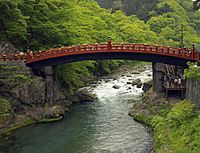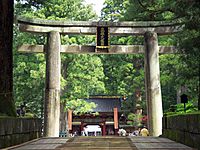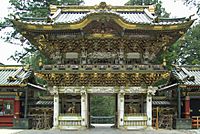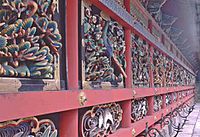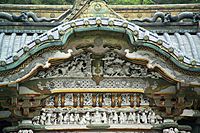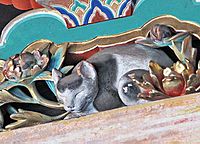Shrines and Temples of Nikkō facts for kids
Quick facts for kids Shrines and Temples of Nikkō * |
|
|---|---|
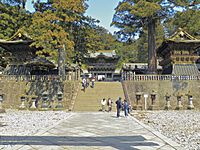
Yomeimon gate of Toshogu shrine
|
|
| Country | Japan |
| Type | Cultural |
| Criteria | i, iv, vi |
| Reference | 913 |
| Region ** | Asia-Pacific |
| Inscription history | |
| Inscription | 1999 (23rd Session) |
|
|
The Shrines and Temples of Nikkō (日光の社寺) is a special place in Nikkō in Tochigi Prefecture, Japan. It is recognized by UNESCO as a World Heritage Site.
This amazing site includes 103 buildings and structures. It also covers the beautiful natural area around them. There are two Shinto shrines and one Buddhist temple that are part of this important site.
Contents
History of Nikkō's Sacred Sites
The area of Nikkō has been a sacred Shinto forest for a very long time, even before recorded history. Buddhist temples were built here starting in the 9th century. In the early 1600s, thousands of Japanese cedar trees were planted, making the area even more beautiful.
The shrines and temples of Nikkō are closely connected to the history of the Tokugawa Shoguns. These were powerful military leaders who ruled Japan for many years.
In 1871, the Shinto and Buddhist areas were officially separated. Three main sites were identified: two Shinto shrine complexes and one Buddhist temple complex.
Later, in 1897, the Japanese government passed a "Law on the Preservation of Shrines and Temples." This law helped protect Nikkō's important buildings.
Finally, in 1999, Nikkō's shrines and temples were named a World Heritage Site. This means they are considered very important for everyone in the world to protect and enjoy.
Today, the World Heritage Site includes nine "National Treasures of Japan." It also has many "Important Cultural Properties." These are buildings and artworks that are very valuable to Japan's history and culture.
Amazing Buildings and Art
Many gates and buildings at Nikkō have incredibly detailed carvings. These carvings are often brightly colored. The colors used today are based on old records from 1753. Experts use these very precise descriptions to help keep Nikkō's history alive and well-preserved.
Important Sites in Nikkō
The World Heritage Site includes three main areas: Futarasan Shrine, Tōshō-gū Shrine, and Rinnō-ji Temple. Each one has its own special history and beautiful buildings.
Futarasan Shrine
The Futarasan Shrine (二荒山神社, Futarasan jinja) is a Shinto shrine. It has 23 structures that are part of the World Heritage site. All of these buildings are registered as "Important Cultural Properties of Japan." This means they are very important historical and artistic treasures.
One famous part of Futarasan Shrine is the Shinkyō (Sacred Bridge). It's a beautiful wooden arched bridge that crosses the Daiya River.
Tōshō-gū Shrine
The Tōshōgū Shrine (東照宮, Tōshō-gū) is perhaps the most famous part of Nikkō. Many of its buildings are included in the World Heritage site. This shrine is dedicated to Tokugawa Ieyasu, the founder of the Tokugawa Shogunate.
Some of the buildings here are even registered as "National Treasures of Japan." There are also 37 "Important Cultural Properties." The Yomeimon gate, with its incredibly detailed carvings and bright colors, is a highlight of Tōshō-gū. You might also see the famous "Three Monkeys" carving here!
Rinnō-ji Temple
The Rinnō Temple (輪王寺, Rinnō-ji) is a Buddhist temple. It has 38 buildings that are part of the World Heritage site. Many of these are "Important Cultural Properties."
One very special part of Rinnō-ji is the Taiyuin Mausoleum. This is where Tokugawa Iemitsu, a grandson of Tokugawa Ieyasu, is enshrined. The main buildings of this mausoleum are considered a "National Treasure of Japan."
Related pages
See also
 In Spanish: Santuarios y templos de Nikkō para niños
In Spanish: Santuarios y templos de Nikkō para niños


